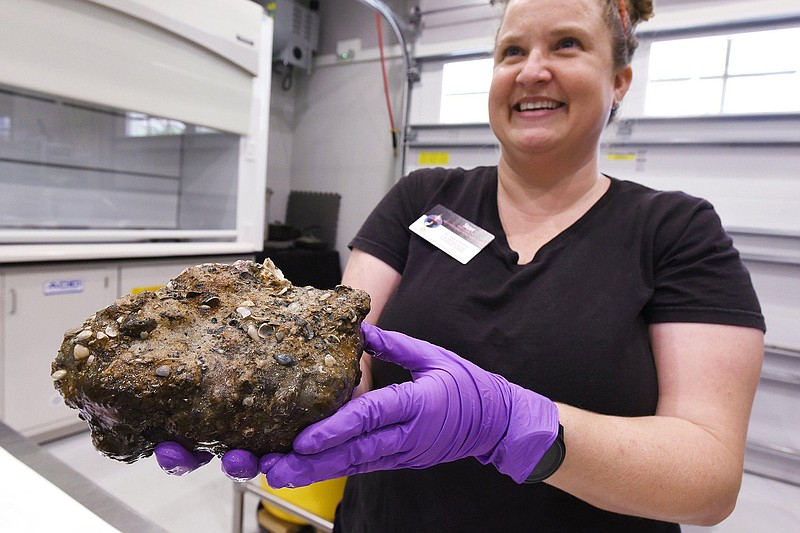ST. AUGUSTINE, Fla. - In the late 1700s, this already old city was a remote outpost, an isolated frontier town stuck a good bit south of the middle of nowhere. So when a merchant ship appeared on the horizon, it must have been a welcome site for the city's inhabitants - though they probably learned not to get too excited until it actually made it into town.
A fair number of incoming ships got stuck on the sandbars outside St. Augustine's notoriously difficult inlet, where they were broken up by waves and their cargo sent to the bottom.
That was the fate of a mysterious merchant vessel that for more than two centuries was hidden under the sand, all its valuable goods made useless, so close and yet far from the people who needed them. Such wrecks happened so often, accounts from the time say, that it got almost routine for those living ashore.
But what do you think the St. Augustinians would have given for some of the peaches that were on board that ship? Marine archaeologists exploring the wreck have found, among the cargo, a number of peach pits, remarkably well preserved - a clue that gives them at least some idea about the ship's history.
Peaches: That probably means it originated in, or at least stopped at, Charleston or Savannah to pick up some of that region's sweet fruit before making its fateful trip to St. Augustine.
Beyond that, there's still a lot to learn about the Anniversary Wreck, so named because a crew from the St. Augustine Lighthouse Archaeological Maritime Program (LAMP) found it in 2015, the 450th anniversary of the city's founding.
Divers, sometimes working in pitch-black conditions, have been bringing up small amounts of cargo since then, which has been painstakingly cleaned and then preserved in LAMP's lab.
The findings have given up a couple of solid clues about the mystery ship.
One comes from a small piece of a Wedgwood plate, a certain style made in England beginning in 1765, making it the oldest merchant shipwreck found in this part of Florida, said Chuck Meide, LAMP's director of maritime research.
Another clue comes from the nature of the cargo itself: big piles of the same items, found together, as if stacked under the ocean floor.
Cauldrons, barrels of iron hardware, brass tacks, pewter plates, cut stone blocks, bricks and tiles, shoe buckles, padlocks, doorknobs, clothing irons and pottery.
From that it's clear the ship was a merchant vessel. "It's just the sheer bulk, and everything is clumped together," said Starr Cox, LAMP's director of archeological preservation. "This is like stuff you would buy in
bulk."
Meide said the Anniversary Wreck gives a tangible look at what life was like in the late 18th century for those in the remote coastal city, where much of what they needed could only be brought by sea from far away.
"It gives us a great insight into consumer behavior here in St. Augustine - what it was like to be someone living in St. Augustine at this time period, through what they bought," he said. "In the future, someone will probably want to look through Amazon records and see what people were buying. This is kind of like that. This is like finding a Walmart truck wrecked and preserved, hundreds of years in the future. This is the nitty-gritty. This is the stuff we know was coming into St. Augustine. This, presumably, was the stuff people asked for and wanted, and that merchants knew they could
sell."
Meide and Cox said it's likely the ship was British, though they can't yet say for certain. Much of its cargo seems to be British, probably from no later than 1800, and the British controlled St. Augustine for two decades, beginning in 1763, until it was given by treaty back to Spain.
The mystery ship could have come from that later Spanish period, though, perhaps captained by an enterprising Englishman looking to do business with the Spanish.
Other wrecks have been found clustered at the old harbor entrance, south of St. Augustine's present-day inlet, where ships had to pick their way through a series of treacherous shoals. The Anniversary Wreck was discovered about a mile north of that by a LAMP research vessel that detected the metal in its cargo, several feet under the sand.
"It's kind of in the wrong place," Meide said. "We don't know if the captain didn't know what he was doing, or if had lost control of the ship as he was about to enter St. Augustine, if there was a storm that broke an anchor line, or if a fire had broken out."
The Anniversary Wreck is the latest project for LAMP's team of archaeologists, who from 2009 to 2015 excavated the remains of another ship they named Storm Wreck.
Storm Wreck dated definitively from 1783, the end of the Revolutionary War, and was carrying desperate British Loyalists from South Carolina, trying to escape from the American colonists. As many as 16 ships carrying Loyalists ran aground on sandbars off St. Augustine, though it's likely rescuers were able to save many of those aboard.
The influx of war refugees helped swell the frontier city's population to about 22,000 people, many black or Native American. That made St. Augustine, for a brief period, almost as large as Philadelphia or New York.
Meide said LAMP will keep working the Anniversary Wreck.
Knowledge gleaned from it will combine with what's been learned Storm Wreck and an earlier wreck, the Industry, a government supply ship from the beginning of the British period. It's all about getting a clearer picture of life in the frontier city, more than two
centuries ago.

